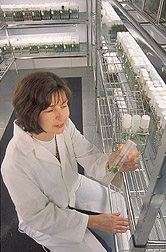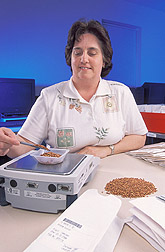Preserving Plants for the Future:
|
|
 Geneticist Gary Pederson (right) and agronomist Roy Pittman prepare vegetative cuttings of wild peanuts for distribution to forage scientists. (K10446-1) |
Wouldn't it be boring to have only one variety of watermelon or pepper? Fruit and vegetable growers strive to provide us with the produce we say we want. That's the whole idea behind marketing! But, fruit and vegetable growers must contend with changing environmental conditions, such as drought, flooding, viruses, and harmful pests to raise enough produce for the market. In Griffin, Georgia, the Agricultural Research Service (ARS) houses the Plant Genetic Resources Conservation Unit, led by Gary Pederson. The unit, part of the National Plant Germplasm System (NPGS), can be viewed as a gold mine of plant species, with more than 82,000 plant samples, or accessions, held in the collection. (See related germplasm story on page 8.) The unit works in conjunction with the Southern Agricultural Experiment Stations, through the University of Georgia, to maintain the collection. The unit serves as an invaluable resource for farmers facing tough or altered growing conditions. "Our unit sent out more than 100,000 plant germplasm (seeds or plant cuttings) samples in the last 3 years. Eighty-eight percent of the requests were from domestic growers; the rest were from foreign countries," says Pederson. By maintaining a repository of plant germplasm, it's possible for varieties used in the past in similar environmental conditions to be used now or in the future, as conditions dictate. |
 Genetic variability in seed color and size in cultivated peanut accessions maintained at Griffin, Georgia. (K10460-1) |
Growing conditions vary from year to year. Pests migrate from one location to another, and a season may be unusually wet or dry. Each plant variety thrives in specific, preferred conditions, and thanks to the efforts of a consortium of labs that make up the NPGS, they are available—and will remain so—to researchers, educators, and producers. The keepers of plant germplasm have the very important task of safeguarding samples of all crops of agricultural importance. Through a national network, the samples are maintained as a means of preserving the productive capacity of agriculture and are provided to requesters around the world. But keeping the seeds and plant samples alive takes a bit of work. Samples stored as seed are dried, cleaned, and packaged before being put in cold or freezer storage. According to seed storage manager Lee Ann Chalkley, seeds are stored in a freezer at about 0 °F or a cold room at 40 °F. Some seeds, like clover and sorghum, can last for 30 or 40 years in freezer storage. Each plant sample, or accession, is entered into the Germplasm Resources Information Network (GRIN) database, operated by the GRIN Database Management Unit, in Beltsville, Maryland. "Before the database was developed, all the records were kept by hand on card files," recalls Chalkley. |
 The in vitro sweetpotato collection consists of more than 700 accessions. Technician Sarah Moon checks the status of some of the samples. (K10452-1) |
Consumers in the Driver's Seat Forty years ago, a trip to the grocery store would have found a limited choice of produce to choose from compared to today's array. Your choice of peppers may have been limited to bell, pimento, or banana. But today, vegetable bins are graced with those and more: cayenne, jalapeno, habanero, and Scotch Bonnet, to name just a few. Today's consumer demands a greater variety of produce, and produce is now used for more than basic cooking needs. The snack industry has also begun to use fruits and vegetables in new ways. Vegetable chips such as sweetpotato are now available next to regular potato chips. These new uses require a different type of vegetable than the baking sweetpotato. Have you ever wondered why the baked sweetpotato you remember and loved from a few years ago seems to taste a little different today? Well, that's because it may not be the exact same sweetpotato. Many factors may play into the change in a variety: consumer preferences, environmental conditions, or disease impact. |
 This clover seedling, being examined by geneticist Gary Pederson, is one of 125 different clover species maintained at the Plant Genetic Resources Conservation Unit. (K10455-1) |
The Environment's Twists and Turns Changes in growing conditions, like climate, rainfall, viruses, fungi, and diseases, are some of the challenges crops face. Different strains of the same plant species may tolerate high heat better than others. One strain may be resistant to a soil fungus present in a farmer's land, while the previous crop strain has succumbed. Matters are complicated when plants are grown in nonnative areas. For instance, Georgia and other southeastern states have been in a drought since 1998, which, thanks to heavy fall rains last year has been reversed. Supermarkets in the United States have a wide range of fresh fruit and vegetable choices. But can you guess which ones are native to North America? Sweetpotato? Nope. Peanuts? Uh-uh. Watermelon? Try again. Actually, most agriculturally important crops in the United States came from other places on the globe. This means crops brought here to be grown had to adjust to the new growing environment. |
 Technician Lee Ann Chalkley weighs sorghum samples for distribution to researchers throughout the world. (K10448-1) |
Bright and Delicious Future Maintaining the variety of plant genetic resources is a delicate task. Plant samples, especially cuttings, must be carefully tended to remain viable. When stocks are low, varieties must be propagated to increase the supply. In fact, some of the plant strains, like sorghum, have been in stock since the 1940s. "The unit boasts an extremely varied collection of plant genetic resources, including legumes, sweetpotatoes, peppers, squash, annual clover, eggplant, and sorghum, to name a few," says Pederson. The Future is Now Accessions are maintained as a shield against genetic vulnerability and as potential solutions to the future challenges faced by U.S. agriculture, particularly in the Southeast. To further protect and enhance the current collection, trips are also conducted to find new varieties. "Though these plants may not seem significant now, they may address some future difficult or different environmental conditions," says Pederson. "Some plants may have a natural resistance to certain diseases and pests, and we may be able to breed a resistant plant with other varieties to confer its resistant properties." |
|
A collection trip to Bolivia yielded strains of peanuts that may be resistant to tomato spotted wilt virus, a disease that reduces peanut size and yield. These are being crossed with southeast U.S. peanut varieties, and some of these initial crossings are being grown and examined in Attapulgus, Georgia. Disease resistance isn't the only reason to look at different plant varieties. Consumer desires also require that growers provide produce with certain traits, like seedless watermelons or very sweet sweetpotatoes. The More We Know... It's not enough just to have and distribute plant material; scientists must also understand why certain varieties are able to survive under difficult conditions. Pederson's research facility is also gearing up to determine the genetic variation of some of the accessions. Initially, peanuts and sorghum, important crops in the Southeast, will be the focus. Other crop plants like peppers, cowpeas, clovers, legumes, and many others will be studied in the future. Knowing the molecular makeup of any organism is the first step in knowing what makes a plant resistant to disease or pests, why a plant gets to be a certain size, and how well it thrives in different environments. The work of the Plant Genetic Resources Conservation Unit, as well as the other components of the NPGS, not only has given us a wonderful array of plant varieties to choose from, but also provides a promise of such diversity for the future.—By Sharon Durham, Agricultural Research Service Information Staff. This research is part of Plant, Microbial, and Insect Genetic Resources, Genomics, and Genetic Improvement, an ARS National Program (#301) described on the World Wide Web at www.nps.ars.usda.gov. Gary Pederson is in the USDA-ARS Plant Genetic Resources Conservation Unit, 1109 Experiment St., Griffin, GA; phone (770) 228-7254, fax (770) 229-3323. "Preserving Plants for the Future: Crop Bounty Is Well Protected" was published in the June 2003 issue of Agricultural Research magazine.
|






